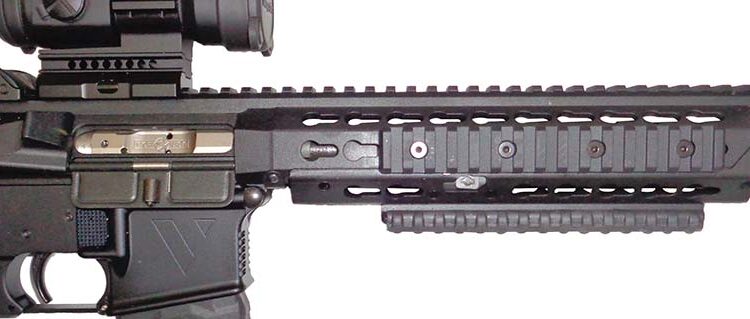By Christopher R. Bartocci
The AR being the most popular rifle in the country, the market is without a doubt a multi-billion dollar industry. Any number of companies have come out of the woodwork producing new/advanced components, rifles and their quality and concepts go from outstanding to absolute garbage. With having so many companies in the game you are bound to come up with some real innovation. Most of this started in the late 1990’s to the early 2000’s. Before the 1994 Assault Weapon Ban the semi-auto market was rather low and unpopular. Primarily Colt was the manufacturer of the AR-platform of rifles. With the ban “sunset” in 2004 the weapon system took off. The lead dog, or should I say horse, Colt was set on military contracts and their commercial rifles went by the wayside, enabling a whole new market for those interested and the rest is history.
In 1994, a former staff writer from Gun World magazine and also a former Knight’s Armament employee by the name of Eric Kincel co-founded Micro-tech knives and lead a small arms division called Unitech Research, Inc. Due to litigations with Knight’s Armament the company was dissolved. Then in 2001 a new company was formed by the name of VLTOR. The company was later bought out by aerospace contractor Abrams Airborne Mfg, Inc (in 2004).
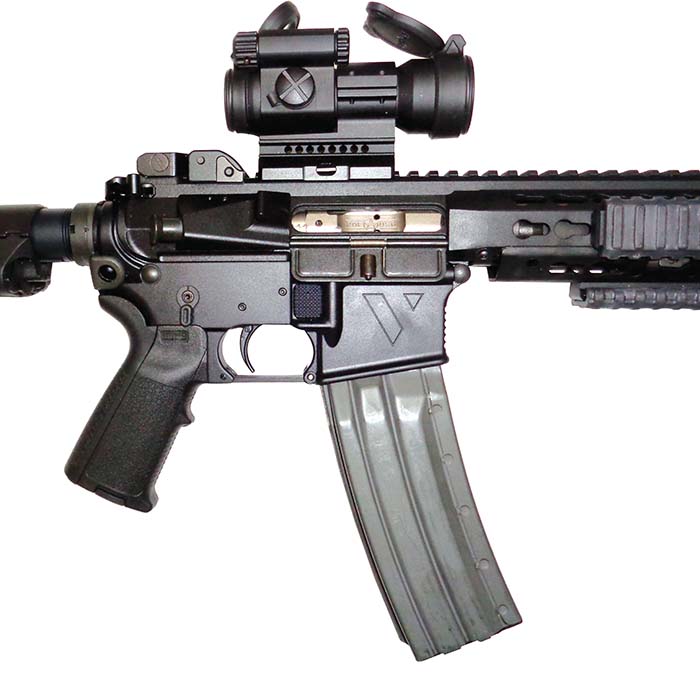
The first true VLTOR product commenced in 2001 and continues as of 2015 to be their most coveted product line, the Modstock. After seeing pictures of the Colt Advanced Combat Rifle, Kincel looked at the triangular shaped stock design. He felt this was a very comfortable stock, much more so than the traditional, thinner Mil-Spec stock. The design of the VLTOR Modstock commenced. The Modstock was widely used for quite a few years until additional improvements were to be made. Now named VLTOR IMOD it has two side panels which each have a waterproof tube which can be used to store batteries (3 CR123 or 2 AA batteries per tube) or anything else that would fit. The butt of the stock has a rubber anti-slip buttpad with a rolled/ angled buttpad with wide traction area. Like the traditional stock there are mounting apparatus for a standard cloth sling and additionally there are ambi quick disconnect swivel sockets. The stock is made from a very strong proprietary polymer which is impervious to the elements. This stock will fit on any mil-spec receiver extension and is also offered in commercial configuration. This stock has been put on many OEM firearms. The Colt SCAR rifles as well as the production LE901 series come standard with this stock. Another variation of the IMOD stock is of a Clubfoot design. The foot of the stock is squared off and not as angular as the standard version. The design of the stock is so you can grab the face of it with the non-shooting hand for more control with use of scoped weapons. VLTOR also produces another stock called the EMOD. This is slightly longer (1.5-inches) and has a larger battery storage compartment that has a door that closes and locks in place. The design of the stock is so you can grab the face of it with the non shooting hand for more control with use of scoped weapons. VLTOR offers both stock assemblies and a VLTOR manufactured receiver extension which has the stock positions numbered on the top. Due to a witness hole in the top of the IMOD/EMOD stock, the user will be able to see what position the stock is in. Either of the buttstocks can be purchased separately or in a “kit” version that will include the stock, receiver extension, spring/buffer kit, lock plate and lock nut.
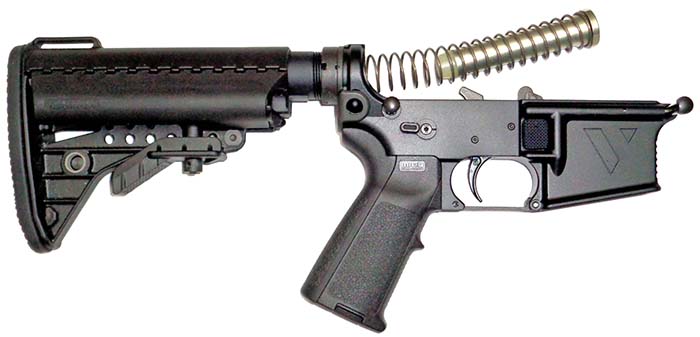
In the 2010 time frame, VLTOR embarked on a new program to deal with an issue every rifleman armed with a fixed stock (M16A2, M16A4, MK12 MOD 0/1) dealt with. The fixed stock rifles were designed on the original M16/M16A1 rifle in the days prior to the use of body armor. The modern soldier has extremely bulky body armor. Also, most soldiers are equipped with optics. This additional bulk on the soldiers shoulder plus the modern optics cause an issue with hindering the soldiers ability to achieve proper eye relief resulting in the soldiers having to put the stock on top of the shooter shoulder. This is a very unstable interface between the shooter’s eye and the optic. Another way around this, the soldier will move the stock off the shoulder/body armor all together and place it on the bicep, along with a body rotation of the weak side forward. This causes additional issues including weapon reliability due to the movement in the body absorb recoil energy the weapon needs to cycle. On carbines, the use of adjustable telescopic stocks cures these issues. The M4 carbine for instance has 4 positions to choose from. The rifles, not so much. To deal with this issue there have been attempts to put standard carbine receiver extensions on rifles with little success. Due to the operating dynamics of the rifle length gas system issues have come up with cyclic rate and bolt carrier bounce.

VLTOR set off to find a solution to this problem and that resulted in the A5 stock system (with EMOD Stock) that was designed as a complete integrated system to offer length of pull adjustability, an enhanced interface with modern body armor and optics without decreasing the reliability of the M16 weapon system by retaining the spring rate and cycle timing of the fixed buttstock. The A5 system optimizes the cycle timing of the 14.5” barreled variants of the carbine family by returning to the spring rate of the fixed stock. The M16A2/M16A4 with the A5 System has a length with stock collapsed of 37 3/8” and fully extended 41 1/8”. The EMOD stock is slightly wider and longer than the standard M4 stock with a noticeable negative pitch of -5 degrees at the top with a decrease to -15 at the toe of the stock. The rubber butt plate is removable resulting in making the stock ½-inch shorter. The stock features two removable battery storage components which hold 4 CR123 or 3 AA batteries. There is a side compartment as well in the clubfoot area that holds two additional CR123 batteries. The Clubfoot and Butterfly Latch design allows the shooter to use the weak hand to steady and hold the stock into the shoulder when using the bipod, improvised rest, or brace without inadvertently releasing the stock latch. The A5 receiver extension has 7 positions rather than the conventional M4 which has 4 positions. The buffer is a midlength buffer with a standard rifle action spring. The internal weights of the A5 buffer, spring rate and cycle timing are balanced to equal or exceed the reliability of the M16 family of rifles with the fixed stock. Third party testing has shown carrier bounce is virtually eliminated with the A5 stock system.
During the research for this article, the author assembled a complete rifle using as much VLTOR equipment as possible. From stock to muzzle is a very good example of the enhanced VLTOR products. Starting at the rear of the rifle, the rifle is equipped with the A5 stock system. However the IMOD stock was selected due to its smaller profile and the author’s preference of the stock latch.

VLTOR got into the lower receiver business in 2009. The lower receiver used on the demo rifle is completely VLTOR and is offered for sale as product number VRA-RA5. The lower receiver is manufactured by VLTOR from a forging of 7075 T6 aircraft grade aluminum. There are a couple enhancements over the standard Mil-Spec receiver. First is the oversized magazine release button. Well over twice the size as the standard magazine release button with slip resistant checkering on the face of the button. This lower receiver is not compatible with the standard magazine release button. On the front of the magazine well are grip enhancing cuts. The receiver is hard coat anodized as per military specifications. On the rear of the receiver is the A5 receiver extension assembly. The receiver extension end plate has been replaced with the VLTOR side Saddle sling plate (Proprietary to the VLTOR lower receiver) which puts a quick detach socket on the left, right and rear of the receiver. The lower receiver assembly came with a standard A2 pistol grip. It was replaced with a Magpul MIAD pistol grip. The safety was a conventional safety but was replaced with a Battle Arms Development ambidextrous safety. The trigger which came with the VLTOR lower receiver assembly was the standard Mil-Spec trigger group. At the same time as this lower arrived, so did the Geissele 2 Stage (G2S). The total weight of the trigger pull is 4.5 pounds. The first stage is 2.5 pounds and the second broke at 2 pounds.
The upper receiver is the 9-inch VLTOR VIS (Versatile Interface Structure)-KM Polylithic upper receiver with slimline profile. The KeyMod variations went into production in 2012. This 21.4 ounce upper receiver assembly appears to be monolithic but in fact is three pieces. In 2007 the original VIS was introduced. The upper receiver is similar to the MIR (forward assist, ejection port cover and fired cartridge case deflector) manufactured by VLTOR. The handguard is manufactured from an extrusion. The handguard and receiver are bonded together by a “Molten Salt Dip Brazing”. The handguard has quad Mil-Std-1913 rails. Ones at 12:00, 3:00 and 9:00 and a removable lower handguard which provides a 6:00 rail. It is held into the receiver by two locking levers, not a slip ring or a screw. All VIS system have M4-type extended feed ramps and any Mil-Spec barrel may be installed with an extended barrel extension. The KM stands for Key mod and the 9 is for 9-inches in length. The rifle build used a midlength gas system. The inside diameter is 1.03 inches. With the proper barrel, with the lower handguard removed the upper is M203 compatible. The VIS will use any standard Mil-Spec barrel but the barrel nut must be the one provided. The barrel nut wrench is provided and is meant for a single use. The KeyMod rail segments are offered in 2-, 4- and 6-inches in length as well as KeyMod Slimline grip panels. The VIS Polylithic upper with quad rails is available with and without the forward assist.

The barrel chosen is a Centurion Arms 16-inch mid-length gas system chrome hammer forged barrel. This is an incredibly accurate barrel. Debate continues between hammer forged versus button cut barrels. Both are excellent. This author’s experience is that hammer forged barrels have a longer service life but button cut barrels prove to have better precision accuracy. The precision accuracy really does not pertain to a combat rifle, the shooter would never see it unless he had a proper scope, ammo and a bench rest. But this is a personal choice, you cannot go wrong with either. The mid-length gas system provides more dwell time for the cartridge case, making extraction easier. The front sight base is the VLTOR VST front sight tower. There are two models. The first and most common are the clamp on and the other requires drilling and pinning. The one chosen was the one requiring drilling and pinning. The front sight folds and is engaged by lifting it into potions. The front sight post is square but is not adjusted via spring loaded plunger and rotated. This post is more like an AK in that you rotate it by a press-fit screw. When folded, there is a Mil-Std-1913 rail. There are two additional options. With and without quick detachment sockets. The one used has the ambi quick detach sockets for installing a sling swivel. The muzzle device chosen is the VLTOR VC Flash Hider. There are two offered, an A1 and a closed bottom A2 version. This rifle is equipped with the A1 version. The rear sight is the VLTOR folding rear sight, This has dual long and short range apertures and is adjustable for windage only.
The charging handle chosen was the VLTOR BCM-GFH ambidextrous Gunfighter. These charging handle debuted in late 2009. VLTOR partnered with Bravo Company on this product. It is designed, manufactured and patented with VLTOR but they have a licensing agreement with Bravo Company to sell them. This is an extremely smooth and comfortable charging handle whether you are left or right handed. The right and left latches are easy to get to and easy to hold onto. VLTOR does offer a standard charging handle (right handed shooter) and one with an extended latch.
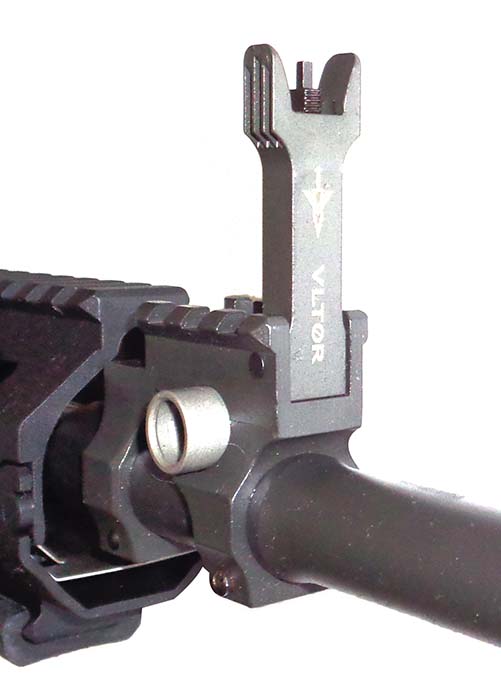
The bolt carrier group chosen is the POF-USA Enhanced direct gas bolt carrier group. The NP3 plated carrier group has three major design improvements. First the bolt carrier is one piece. The steel gas key screws into the face of the “tombstone” of the carrier and is pinned in place. There are basically two places you get gas loss in a direct gas rifle. One is the front sight base and the second is the carrier key. If the carrier keys were to break, the carbon seal is broken between the carrier key and the bolt carrier; gas leaks and the rifle will short stroke. The POF carrier design completely eliminates the possibility of gas loss through the bolt carrier. The second major improvement is the use of the POF NP3 coated Roller Cam. The standard cam is square in shape. Some have the edges rounded, others do not. This scrapes along the inside of the upper receiver which will cause wear on the aluminum receiver. This happens anytime two pieces of metal scrape and one is harder than the other. The roller cam eliminates the steel edges scraping the inside of the receiver, drastically reducing internal wear. This is even more prevalent in piston operated rifles. You will see a cut in the inside of the upper receiver just behind the cam notch. This is prevented for the most part with Roller Cam. The third major improvement is the material the bolt is manufactured from 9310 steel which is a 7% improvement over Carpenter 158 steel (Mil-Spec). The extractor has enhanced geometry for better support of the extractor.
This rifle was tested with 500 rounds of Black Hills Ammunition- .223 Rem 55gr Full Metal Jacket ammunition. There were no malfunctions of any sort. The lower receiver was tested for magazine compatibility as well. More than 15 different types of magazines were tested including Magpul, Lancer, USGI, Hexmag, Hera Arms, Ultimag, CProducts Defense, HK poly & steel, Mission First Tactical, Tangodown, Surefire and Troy to name a few. No malfunctions of any sort.
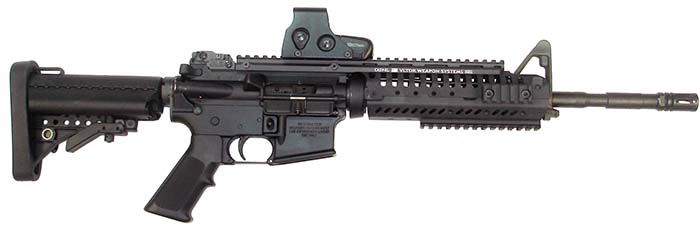
Another very popular product is the MUR (Modular Upper Receiver). In fact this product is used on several high tier OEM rifles such as Noveske. This upper is manufactured from a 7075 T6 aircraft grade forging. It is stress relieved, heat treated, aged twice and cryogenic treated. The receiver is precision machined and then finished off by hand. As per mil-spec the bore is coated with dry film lubricant over the anodizing. Two models are offered, the MUR-1A which has the forward assist assembly and the MUR-1S which excludes the forward assist.
The CAS-V was originally developed for the Navy EOD for MK18 Mod0 and M4 carbines. This is a drop-in rail system that can go on any Mil-Spec rifle with a flattop upper receiver and a delta ring assembly. The rail is free floating and M203 grenade launcher compatible. The lower shield is removable permitting installation of the grenade launcher. It adds less than 1 pound to the overall weight of the rifle. Made from aircraft grade aluminum the rear of the CAS-V piggy-backs on the upper receiver and is held in by two screws. The top rail is a ridged, continuous rail section along the top rail. There are two quick detach mounting sockets on both right and left sides. The CAS-V is offered in models which are removable rail segments as well as KeyMod.
Through the years another product this author has used regularly is their receiver extension end plates/lock plates. The SASE end plates are offered in two configurations. The first it the SASE HK-style hook. There is a hoop on one side. The lock pin can be placed on either side so the hoop can be on the left of right side. There is also a even larger hoop model of this. The third model is one for a cloth sling. These fit any Mil-Spec receiver.
In 2008, VLTOR began offering complete rifles. They started off with a 14.5-inch barrel with a MUR-1A upper and CAS-V handguard. In their current catalog they offer ten different variations. Standard carbine, short barrel as well as pistol variations. They also offer customizable rifles to military and law enforcement customers.
VLTOR has always been on the leading edge of high tier product development. They have several military contracts for various components. The products in this article are just the ones they make on the AR-platform alone. They also make components for the FN SCAR rifles, M14/M1A and AK. They even produce a sound suppressor for an AK74. Every year VLTOR delivers new innovative products to the industry and enjoy contracts from all parts of the industry. This author has used their stock assemblies on many builds that have been featured for several years in SAR. We cannot wait to see what 2016 brings.
| This article first appeared in Small Arms Review V20N7 (September 2016) |



